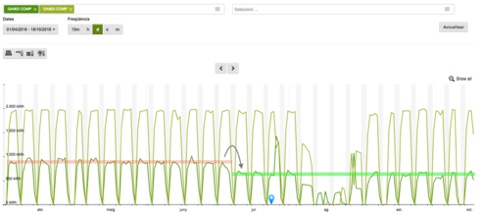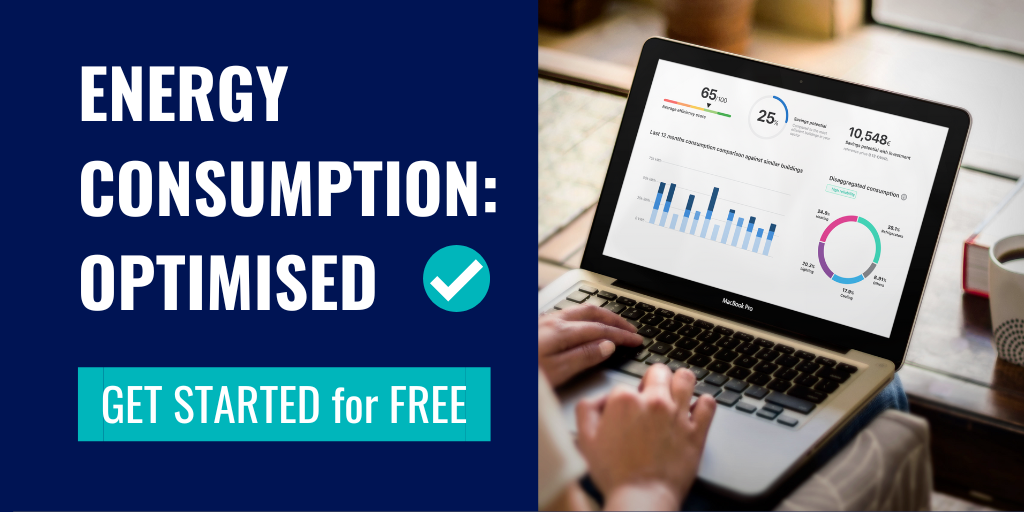Compressed air can be defined as a mass of air that is at a higher pressure than atmospheric. It is used as energy or to accumulate it for later use. It is considered by some authors as the fourth energy, after water, gas and electricity.
The use of compressed air in manufacturing is very common, as it is used for many applications, it is faster than hydraulic systems and it can be generated locally. The vast majority of production processes use it. In this article, we review the main advantages of using compressed air system monitoring.
An air compressor is required to obtain compressed air. Compressors are machines that take in atmospheric air to increase its pressure. This process consumes a significant amount of electricity. For this reason, compressed air installations including the equipment that produces the air, its complementary elements and the distribution pipe network, must be in good condition and minimise energy consumption.
Reality tells us something quite different. Compressed air systems have become a ‘black box’ for the total energy consumption of companies, a constant and unknown economic expense. Because they serve so many applications, their use is highly variable, making it very difficult to know whether the system is optimised and in good condition.
The use of Energy Monitoring Software such as DEXMA allows to decipher and characterise this black box of consumption.
Why compressed air system monitoring?
The main advantages of compressed air system monitoring as part of energy efficiency projects in manufacturing are as follows:
 Detection and identification of inefficiencies
Detection and identification of inefficiencies
DEXMA Optimise provides real-time, sectorised information on the electricity consumption of air compressors. In this way, we are able to know when, how much and where consumptions come from.
The most common case in the industry is to identify passive consumption during the night and at weekends when production is stopped.
 Know and understand the origin of compressed air consumption
Know and understand the origin of compressed air consumption
Having the industrial plant monitored allows the different production processes to be related to compressed air consumption. We can determine that consumption is directly related to a production process (a production line) and that permanent consumption (which does not depend on any type of production process). For example, by carrying out no-load power consumption tests.
Source: Passive consumption during weekends, which is an example of possible system leakage.
Compressor consumption when production is stopped is mostly due to leaks. This consumption is not providing any value and must be minimised as much as possible. By carrying out different tests, the specific origin of these leaks can be determined.
At the same time, the baselines of compressor consumption can be calculated with respect to production, which will also give us a fixed term (ordered by origin) that will quantify the consumption that leaks.
 Calculate the cost of inefficiencies
Calculate the cost of inefficiencies
Once we have identified the consumption, we can quantify the cost of leaks, air over-pressure, the use of old compressors, passive consumption, etc.
Quantifying inefficiencies in monetary terms allows us to know their weight in relation to the global energy cost and to prioritise investments.
 Application and verification of corrective measures effectiveness
Application and verification of corrective measures effectiveness
Once the problematic points have been identified, it is essential to check that the measures taken to correct the issues are producing the expected results.
With Dexma we can compare consumptions from different time periods and quantify the savings achieved. In addition, it allows us to verify if the savings are similar to those expected through the measurement and verification projects (M&V).
 Optimal maintenance of the compressed air system
Optimal maintenance of the compressed air system
Once the compressed air system has been optimised, monitoring allows us to maintain this profile of maximum energy efficiency thanks to the programming of alarms in the event of any abnormal situation.
These alarms can also be programmed to assist in the preventive maintenance of the compressors. An upward trend in consumption may indicate a loss of performance of the equipment.
Source: Project of measurement and verification for adjustments in the pressure of the compressors.
 Anomaly detection
Anomaly detection
Thanks to continuous monitoring we can detect problems in the installation more quickly and accurately. In the vast majority of industries where there is no monitoring, problems are detected in the periodic maintenance checks that are carried out, so that several weeks can pass without the problem being solved.
With Dexma, the reaction time is much shorter and therefore the negative impact is minimised.
Source: Change in compressor consumption profile after weeks of operation in the new regime.
Compressed Air System: a key to Energy Efficiency in Manufacturing
Energy monitoring of compressed air systems has become a priority for industries committed to energy efficiency. It is a key point in electricity consumption with a very important potential for improvement.
From Enertips, as an energy efficiency consultancy, we help the industry to optimise consumption and minimise costs, achieving greater competitiveness and being more respectful of the environment.
Editor’s Note: This original guest article was published here with kind permission from the author, Dani Puigdomenèch.
Dani Puigdomenèch is the Co-founder and Project Manager of Enertips. Enertips is an energy consultancy with extensive experience in audits and energy efficiency projects in SMEs and large companies in the industrial sector.








